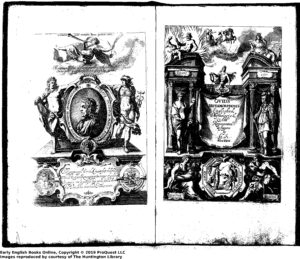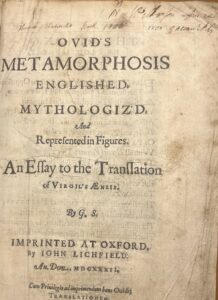George Sandys’ 1632 publication Ovid’s Metamorphoses Englished, Mythologiz’d, and Represented in Figures was, at the time, only his most recent translation of Ovid’s epic. He first produced a shorter translation, only the first five books of Metamorphosis, in 1621, just before traveling to the Virginian colony of Jamestown (Ellison). Sandys was a prolific travel writer whose works were read by the likes of Francis Bacon, Michael Drayton, and John Milton, but perfecting his translations of Metamorphosis seemed to be a passion project for him.

Figure 1: George Sandys, courtesy of the Oxford Dictionary of National Biography
After the first illustrated translation of 1632, Sandys published a second illustrated version in 1640. John Legat published this edition in London as John Lichfield, the Oxford printer who published the 1632 edition, had passed away five years earlier in 1635 (Roberts). The differences between the two illustrated editions are unclear, aside from a portrait accompanying the frontispiece (Figure 2). The Latin inscriptions and Roman-style wreath on the subject’s head suggest the portrait depicts Ovid, the original author of Metamorphosis. Various other versions of Sandys’ Metamorphosis translations would be published long after his death in 1644. Not all were expanded editions of the illustrated versions—many were different versions of his earlier English translations. This was likely an economic decision, as illustrated books were considerably more expensive to produce.

Figure 2: Portrait of Ovid alongside the frontispiece in the 1640 illustrated edition. Courtesy of Early English Books Online, scanned reproduction courtesy of The Huntington Library.
I
It is difficult to determine the true worth of a copy of Ovid’s Metamorphoses Englished, Mythologiz’d, and Represented in Figures, such as the one held in the Dickinson College Archives and Special Collections. Dickinson’s copy has extreme wear on the back cover, which would diminish its worth. Another copy of the same 1632 illustrated edition is listed online for $3,500 by Phillip J. Pirages Fine Books and Manuscripts. The seller’s description indicates slightly less damage to the binding, but similar levels of preservation to the Dickinson copy. However, it would be difficult to determine if the books were truly of a similar condition and therefore of similar value without comparing them side by side. Interestingly, Liber Antiques lists a copy of the 1640 second illustrated edition for $9,500. This difference in price begs questioning, but it is unclear why the two editions are valued so differently. It could be due to the conditions of the individual copies, or perhaps the second illustrated edition had fewer copies printed and is therefore more rare, but there is no way to be certain without a professional appraisal. Whatever the factor is, it is unlikely that the illustrations themselves contribute to the value. Copies of Sandys’ 1626 translation—not illustrated—can be found online ranging in price from $7,800-$9,000. While surprising, this indicates that the illustrations have little, if any, bearing on the worth of the book.
Discerning the actual fate of the Dickinson College Archives’ copy before it arrived in Carlisle proves a more daunting task. There are not many physical clues as to who owned the book over the years and how it was used aside from a few inscriptions in ink on the title page (See Figure 3).

Figure 3: Title page with handwritten inscriptions at the top of the page.
The phrase “Thomas Chadwick’s Book” can be made out alongside the year “1780.” About an inch to the right, the year “1730” is written. Other marginalia on the page, clearly from another time given the variations in handwriting and ink color, is illegible. The writing tells us that a man named Thomas Chadwick once owned this book. Perhaps he acquired it in 1780, or that was just the year he chose to claim ownership of it in writing. No results come up for Thomas Chadwick in the Oxford Dictionary of National Biography, so it is probable that Mr. Chadwick was by all accounts a regular man who enjoyed classical literature. There is also the possibility that he may have lived in the United States of America, which would have been in the middle of the Revolutionary War at the time Chadwick’s inscription implies that he owned it. There are no other identifying marks indicative of other previous owners of the Dickinson copy of Ovid’s Metamorphoses.
While there seems to be scant information on the physical copies of the 1632 illustrated edition Ovid’s Metamorphoses Englished, Mythologiz’d, and Represented in Figures and its subsequent editions, the text itself continues to enjoy longevity. The University of Nebraska Press reprinted the original text in 1970 and other publishers have followed suit. A 2010 reprint by Kessinger Publishing is currently on sale on Amazon, for $54.60 instead of $59.95. In recent years, faculty at the University of Virginia have digitized the 1632 illustrated edition as an etext for free use. The permeation of Sandys’ work into the twenty-first century is a testament to his talent as a translator and writer. As a friend of King Charles I, Sandys enjoyed special privileges such as the exclusive publication rights to translations of Metamorphosis following the publication of his first full translation in 1626 (Bauman Rare Books). Though Sandys himself may not be a household name, many of his peers and the writers he inspired are well-known. He was a contemporary of Milton and Sir Francis Bacon, who read his work, and influenced the likes of John Dryden and Alexander Pope with the poeticism of his translations. He was revered for maintaining the qualities in translation that made Metamorphosis (at least in format) an epic poem, down to the number of lines in Ovid’s original Latin text. Given his poetic prowess and attention to detail, it is no wonder Sandys’ translation is one that stands the test of time.
Works Cited
Ellison, James. “Sandys, George (1578–1644), writer and traveller.” Oxford Dictionary of National Biography. January 03, 2008. Oxford University Press.
Gordon, Laura. “SANDYS, George.” Database of Classical Scholars | Rutgers, The State University of New Jersey, https://dbcs.rutgers.edu/all-scholars/9091-sandys-george.
“Ovid’s Metamorphosis Englished – Ovid – Bauman Rare Books.” Baumanrarebooks.com, 2024, [LINK]. Accessed 7 Dec. 2024.
Roberts, R. Julian. “Lichfield, Leonard (bap. 1604, d. 1657), printer.” Oxford Dictionary of National Biography. September 23, 2004. Oxford University Press.
Works Consulted
Frequently Asked Questions | ABAA. https://www.abaa.org/about-antiquarian-books/faq.
Sandys’ Ovid 1632 (Linked Table of Contents)–Ovid Illustrated, University of Virginia Electronic Text Center. https://ovid.lib.virginia.edu/sandys/contents.htm.
Additional Links
Listing of illustrated 1632 edition by Phillip J. Pirages Fine Books and Manuscripts:
Listing of 1640 illustrated edition by Liber Antiques:
Kessinger Publishing’s 2010 reprint on Amazon:
https://www.amazon.com/Metamorphosis-Englished-Mythologized-Represented-Figures/dp/1169810470
Leave a Reply